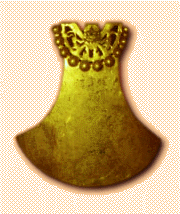|
The Return of a Stolen Cultural Treasure to Peru An Exhibition of a Moche Gold Artifact at the University of Pennsylvania Museum |
|
|
. . . and its Remarkable Odyssey: |
 |
* stolen from an ancient royal Peruvian tomb at the site of Sipan * circulated through a complex network of international smuggling * recovered by the FBI in Philadelphia and held as evidence * presented to Peruvian Ambassador Ricardo Luna * loaned to the University of Pennsylvania Museum for special temporary exhibition * returned to Peru after exhibition |
|
Gold backflaps were an important part of the royal costumes of the Moche elite and were worn suspended from the waist, covering the backside. Backflaps have been found by archaeologists in the tombs of several Warrior-Priests, who wore them as armor during hand-to-hand combat and as a symbol of power during rituals. The Moche culture flourished on the dry deserts of the North Coast of Peru between 200 BC and AD 700. Archaeological study of Moche cities has shown that the society was made up of Warrior-Priest rulers, weavers, metalsmiths, potters, farmers, and fishermen. Looting of ancient sites to obtain objects for sale has a major impact on archaeological sites, because important knowledge about ancient civilizations is lost forever once the tombs, houses, murals, and temples are disturbed and the associated objects are removed from their original location. In the case of the gold backflap now showing at the Museum, two of the looters were found and sentenced, but one smuggler is still at large. Though the backflap has been recovered, archaeological evidence originally associated with it is gone forever. |
|
MocheHomepage | MocheWebsite |